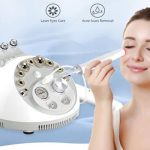Maintaining a consistent skincare routine is crucial for achieving healthy and radiant skin. Among the various skincare treatments available, hydrodermabrasion has gained popularity for its effectiveness in exfoliating and rejuvenating the skin. But how often should you have hydrodermabrasion sessions? In this blog post, we will explore the frequency of hydrodermabrasion and provide guidelines to help you determine the ideal schedule for your skin.
Understanding Hydrodermabrasion
Hydrodermabrasion is a non-invasive skincare procedure that combines the benefits of traditional microdermabrasion with the infusion of hydrating and nourishing serums. During the treatment, like the handheld beauty device from beautyproductmaufacturer.com exfoliates the outer layer of the skin, removing dead cells and unclogging pores. Simultaneously, a gentle stream of water is used to deliver serums that moisturize and revitalize the skin.
The procedure offers several advantages, including improved skin texture, reduced appearance of fine lines and wrinkles, diminished hyperpigmentation, and increased collagen production. However, before diving into the frequency of hydrodermabrasion, it is important to consider a few factors.
Determining the Ideal Frequency
- Consultation with a Skincare Professional: Before starting hydrodermabrasion or any other skincare treatment, it is advisable to consult with a qualified skincare professional. They can assess your skin type, condition, and specific needs to provide personalized recommendations on the frequency of hydrodermabrasion.
- Skin Type and Condition: Different skin types and conditions may require varying frequencies of hydrodermabrasion. Individuals with normal or combination skin can typically undergo the treatment every four to six weeks. Oily or acne-prone skin may benefit from more frequent sessions, approximately every two to four weeks. On the other hand, individuals with dry or sensitive skin should space out the treatments, opting for sessions every six to eight weeks to avoid excessive dryness or irritation.
- Treatment Goals and Desired Results: Consider your treatment goals and the desired results from hydrodermabrasion. If you are targeting specific skin concerns, such as acne scars or hyperpigmentation, a series of initial sessions spaced closer together may be recommended. Once the desired improvement is achieved, you can transition to a maintenance schedule.
- Potential Side Effects and Downtime: Although hydrodermabrasion is generally a gentle procedure with minimal downtime, some individuals may experience temporary redness, sensitivity, or mild peeling after the treatment. Taking these factors into account, it is advisable to schedule sessions accordingly, allowing your skin to fully recover between treatments.
- Consideration of Other Skincare Treatments and Routines: It’s important to consider other skincare treatments and routines you may be incorporating into your regimen. For instance, if you regularly use chemical peels or other exfoliating products, it may be necessary to adjust the frequency of hydrodermabrasion to avoid over-exfoliation and irritation.
General Guidelines for Frequency
Now that we have discussed the factors to consider, let’s explore some general guidelines for the frequency of hydrodermabrasion based on different skin types:
- Normal or Combination Skin: Individuals with normal or combination skin can benefit from hydrodermabrasion sessions every four to six weeks. This timeframe allows for adequate exfoliation and rejuvenation without causing excessive dryness or irritation.
- Oily or Acne-Prone Skin: If you have oily or acne-prone skin, more frequent hydrodermabrasion sessions may be advisable. Aim for treatments every two to four weeks to help control excess oil production, unclog pores, and reduce acne breakouts. Regular hydrodermabrasion can also aid in minimizing the appearance of acne scars.
- Dry or Sensitive Skin: Individuals with dry or sensitive skin should approach hydrodermabrasion with caution to prevent excessive dryness or irritation. It is recommended to schedule sessions every six to eight weeks, allowing sufficient time for the skin to recover and maintain its moisture balance. Additionally, using gentle and hydrating skincare products alongside hydrodermabrasion can help support the skin’s barrier function.
- Adjusting Frequency Based on Seasonal Changes: It’s important to adjust the frequency of hydrodermabrasion based on seasonal changes and the needs of your skin. For example, during the winter months when the air is drier, you may want to extend the time between sessions to avoid exacerbating dryness. Conversely, in the summer when the skin may be more exposed to sun damage and increased oil production, scheduling sessions closer together can help keep the skin clear and refreshed.
- Importance of Listening to Your Skin: Ultimately, the best guide for determining the ideal frequency of hydrodermabrasion is listening to your own skin. Pay attention to how your skin responds after each session. If you notice signs of excessive dryness, redness, or irritation, it may be necessary to decrease the frequency or adjust the intensity of the treatment. Conversely, if your skin feels dull and congested between sessions, you may consider scheduling more frequent treatments.
Maintaining Results and Long-Term Care
To maximize the benefits of hydrodermabrasion and maintain long-term results, it is important to follow a comprehensive skincare routine. Consider the following steps:
- Post-Treatment Skincare Routine: After each hydrodermabrasion session, be sure to follow the recommended post-treatment skincare routine provided by your skincare professional. This may include applying soothing serums, hydrating moisturizers, and using sun protection.
- Protection Against Sun Damage: Protecting your skin from the harmful effects of the sun is crucial. Apply a broad-spectrum sunscreen with an SPF of 30 or higher daily, even when it’s cloudy. Sunscreen helps prevent premature aging, hyperpigmentation, and other sun-related skin damage.
- Importance of Hydration and Moisturization: Hydration is key to maintaining healthy and supple skin. Drink plenty of water throughout the day and use moisturizers that suit your skin type to lock in moisture. Hydrated skin helps maintain the benefits of hydrodermabrasion and promotes a youthful complexion.
- Incorporating Hydrodermabrasion into a Long-Term Skincare Plan: Hydrodermabrasion is most effective when used as part of a long-term skincare plan. Consider integrating the treatment into your regular skincare routine, complementing it with other beneficial practices such as gentle cleansing, regular exfoliation, and targeted treatments for specific skin concerns.
Conclusion
The frequency of hydrodermabrasion depends on various factors such as skin type, condition, treatment goals, and individual response. Consulting with a skincare professional is essential to determine the optimal schedule for your specific needs. By following the guidelines provided and listening to your skin’s feedback, you can enjoy the rejuvenating benefits of hydrodermabrasion while maintaining a healthy and radiant complexion.
Remember, skincare is a journey, and finding the right balance of treatments and routines may require some experimentation. With proper care and attention, hydrodermabrasion can become an integral part of your skincare regimen, helping you achieve and maintain the glowing skin you desire.



